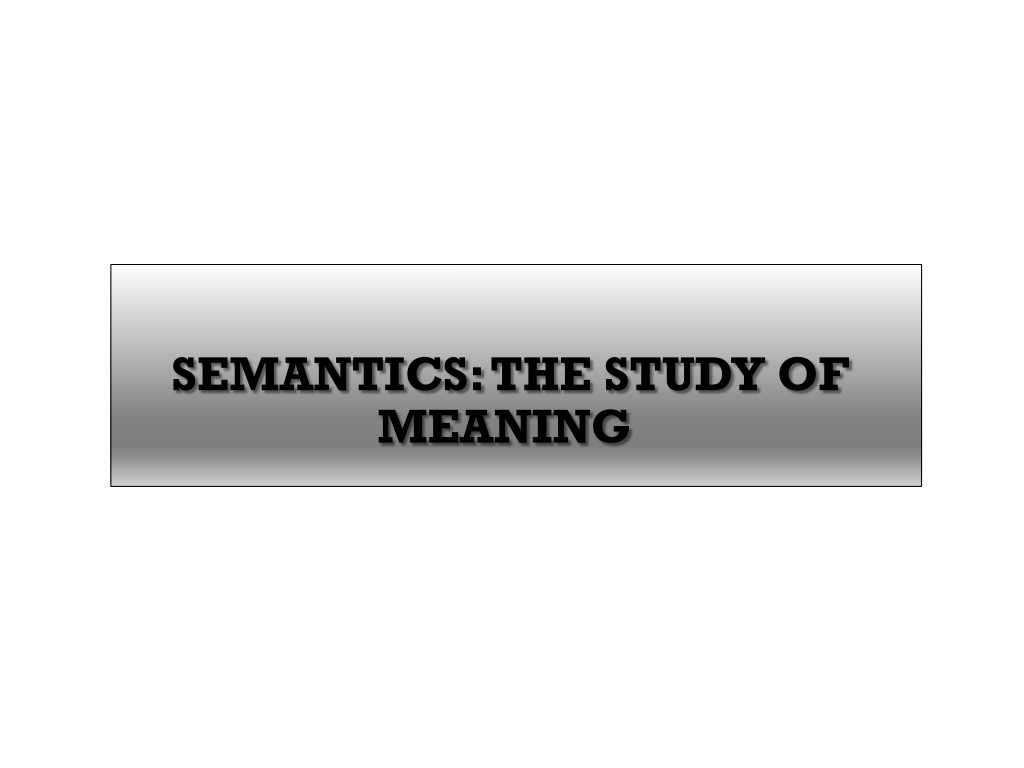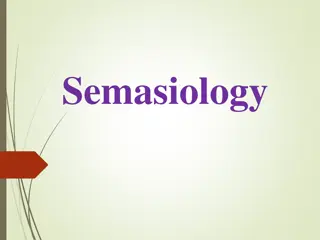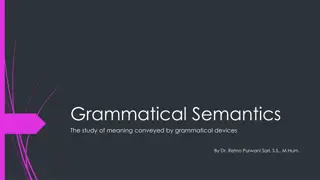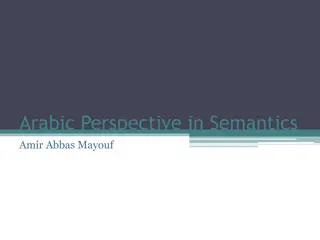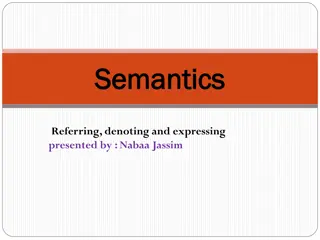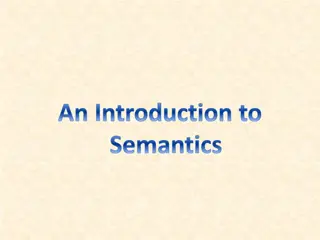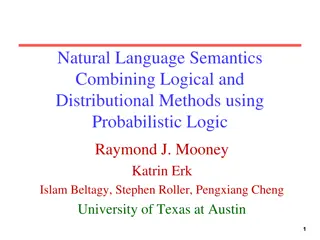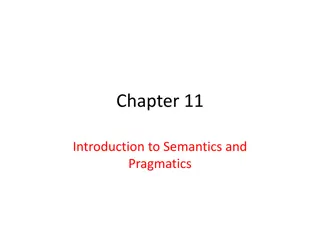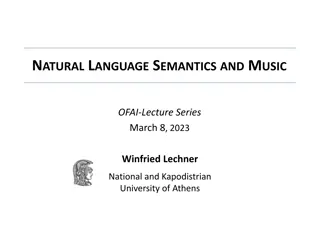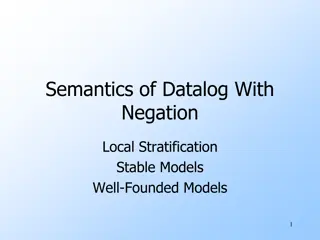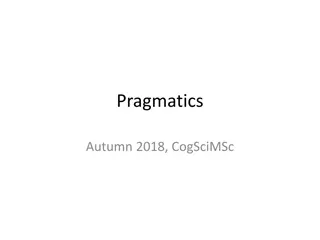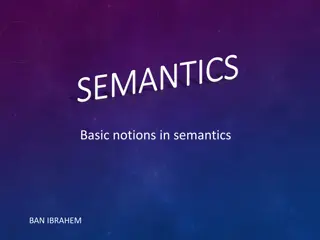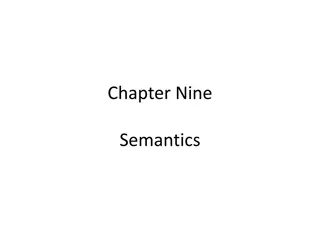Exploring Semantics: The Study of Meaning
Semantics is a branch of linguistics that delves into the study of meaning in language. It involves understanding how words and constructions combine to convey semantic acceptability. Linguists explore lexical and sentence meanings, semantic fields, synonyms, opposites, and more to decipher linguistic nuances. The quest is to unravel why specific words and phrases are deemed acceptable while others are not, leading to a deeper comprehension of language structure and communication.
Download Presentation

Please find below an Image/Link to download the presentation.
The content on the website is provided AS IS for your information and personal use only. It may not be sold, licensed, or shared on other websites without obtaining consent from the author. Download presentation by click this link. If you encounter any issues during the download, it is possible that the publisher has removed the file from their server.
E N D
Presentation Transcript
SEMANTICS: THE STUDY OF MEANING
OVERVIEW 1. Semantics 2. Word Meaning i. Semantic Fields ii. Synonyms iii. Opposites iv. Inclusion 3. Semantic Fuzziness 4. Sentence meaning
SEMANTICS The linguistic study of meaning is called semantics. Semantics can be defined as a branch of linguistics that deals with meaning; it seeks to understand why certain words and constructions can be combined together in a semantically acceptable way, while others cannot. Humans are able to distinguish meaningful sentences from contradictory or meaningless ones. They can also recognize sentences which have similar meanings, and can detect ambiguous sentences.
SEMANTICS A linguist who is studying meaning tries to understand why certain words and constructions can be combined together in a semantically acceptable way, while others cannot. Consider the following sentences: 1. My brother is a bachelor. 2. ! My brother is a spinster.
SEMANTICS A linguist studying semantics would also like to know why anyone who knows a language can recognize certain phrases and sentences as having similar meanings. Consider the examples below: 1. I am fatigued and I wish to get some sleep. 2. I m tired and I want to go to bed.
SEMANTICS Linguistic meaning involves two levels: lexical meaning and sentence meaning. Linguists studying semantics want to understand two types of relationships : 1. word-to-word relationship 2. Word-to-world relationship Linguists are interested primarily in the relationship of words (lexical items )to one another, and only secondarily in their relationship to the world.
WORD MEANING There are three preliminary points that needs to be clarified when studying lexical meaning. 1. The study of lexical meaning is mainly concerned with content words rather than function words. 2. The focus is often on descriptive meaning of words rather than their connotative meanings. 3. We must be aware that meaning is double-faced, as one element of the word meaning is part of a language system, but it is used to refer to things in the outside world.
WORD MEANING Linguists believe that the best way to deal with lexical meaning in a language system is by identifying the semantic relationship between different lexical items (words). These relationships include: 1. semantic fields, 2. Synonymy 3. Opposites (antonym) 4. Classification (inclusion)
SEMANTIC FIELDS Each language cuts up the world in different ways, thus, each language has different lexical structure. It is important to deal with the lexical structure of a language rather than with isolated words. This lexical structure can be divided into different semantic fields. Semantic fields are different across languages. Compare the semantic field of family relation in Arabic and English.
SEMANTIC FIELDS A semantic field is a group of lexical items that seem to belong together in a lexical structure. Each lexical item (word) in a semantic field can be defined by its relation to the other members of the group. Semantic fields can give a useful picture as to how a particular semantic area is divided up. It would be wrong, however, to assume that lexical items cover an entire field like a smooth mosaic. In fact, there are plenty of gaps and overlaps.
SEMANTIC FIELDS To cope with overlap in semantic fields, linguists hoped that lexical meaning might be possible to be deconstructed into its basic elements in a similar fashion to phonemes in phonology. Therefore, they proposed a method known as componential analysis to split up the components of lexical items to cope with the problem of overlap in semantic fields. However, it is somewhat inaccurate to speak of the meaning of words as being composed out of a set of separate components.
SYNONYMY Synonymy is another lexical relation that clarifies how lexical items can be linked to gather. Lexical items can be regarded as synonymous if they can be used interchangeably without altering the meaning of an utterance. By studying interchangeable items, a linguist can build up a picture of those sentences with similar meanings. Perfect synonyms are very rare, because it is very unusual for two lexical items to have exactly the same meanings in all contexts. Consider the following synonymous pair of word (get & obtain)
OPPOSITES Opposites refer to different words that are in an incompatible binary relationship. Opposites can be of three kinds. 1. Absolute opposites: wherein the negative of one implies the other (live vs. die). 2. Relative (not absolute) opposites which are relative to some standards (big vs. small). 3. Converse opposites in which the choice of one opposite rather than another depends on the angle from which you view the situation being described (give vs. take).
INCLUSION Inclusion (classification) is another lexical relationship to study lexical meaning. Inclusion is a relationship between different lexical items in which these lexical items are arranged in a hierarchical structure. Inclusion enables us to understand the multiple links between different words.
INCLUSION The advantages of inclusion are: 1. It enables us to understand the multiple links between different words, 2. and it can sometimes be expressed by means of logical notation, so allowing us to be explicit in our description. Indeed, a few linguists have claimed that the entire meaning of a word can be expressed in terms of its logical relationships with other words.
SEMANTIC FUZZINESS The lexical relationships we have discussed so far assume that words have an agreed-upon meaning which we can discover and describe. This is not always the case, as there are some words that are characterized by fuzzy boundaries. That is, they do not have well defined meaning. Fuzziness and family resemblance provide problems for understanding lexical meaning, because they make it hard to categorize lexical items in clear-cut lexical relationships. These problems indicate that it is impossible to set down fixed meanings for all words.
SEMANTIC FUZZINESS Fuzziness, then, means that words often have fuzzy edges or no clear boundaries. Family resemblance means that a word, such as furniture, covers a whole range of things, which share characteristics with one another, as do members of a family. Yet it may be impossible to think up a set of characteristics which describes them all.
SEMANTIC FUZZINESS Humans tend to understand and memorize meaning in terms of prototypes. Prototypes represent idealized images of concepts or items in the world; thinking of lexical meaning in terms of prototypes is what gives linguistic meaning its flexibility. Humans do not have fixed meanings in their minds; they mostly work from prototypes or typical examples and build for themselves mental models (or representations) which incorporate them in order to represent and talk about the world around them.
SENTENCE MEANING The term representation does not only covers subconscious or inherited representations, but also those presentation that are consciously put across by, say, politicians, when they invent euphemisms to manipulate their audience. For instance, the expression pin-point strikes can lead people into believing that bombs can be precisely dropped on particular targets. Lexical meaning of words and the way they are combined together tells us quite a lot about the meaning of sentences, since sentences are individual words, linked together by means of the syntax.
SENTENCE MEANING The amalgamation of lexical meaning and syntax does not only enable us to reject anomalous sentences, it also allows us to make deductions about normal sentences. These deductions are called entailments. Entailment refers to the deduction of extra meaning that is not explicitly included in the lexical items (words) used in the sentence. The logical relationship of entailment can enable us to understand why some sentences are contradictory.
SENTENCE MEANING Some semanticists hope that formal logical systems will, one day, handle semantic representations , as well as the meaning of sentences, adequately. Formal logical systems can (in theory) provide formulae for the representation of the sentences of any language in order to: 1. show the logical relationships which exist between and among sentences, 2. and to show certain ambiguities quite clearly.
